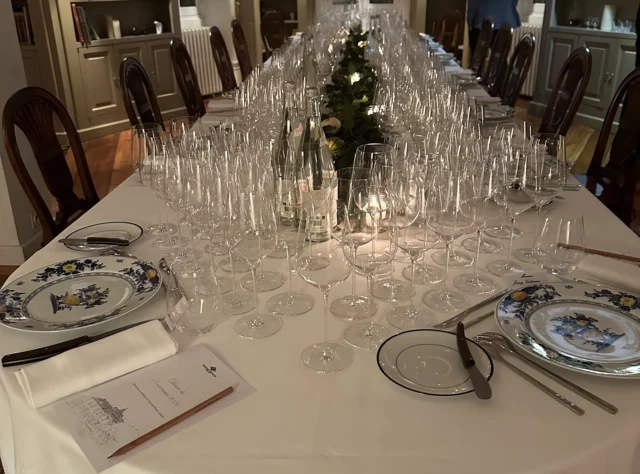Domaine Faiveley
Updated Sep 2022
Historical
This illustrious company has been based in Nuits-St-Georges since Pierre Faiveley founded the house in 1825. His son Joseph gave his name to the family business, to be followed by the first François, then Georges (instrumental in founding the Chevaliers du Tastevin) and Guy, who developed the business in the Côte Chalonnaise. Then came François, who has recently retired, and since 2005 his son Erwan, born in 1979, joined by his younger sister Eve in 2014. The label now uses Domaine Faiveley for the wines from their own vineyards, or Joseph Faiveley for négociant bottlings.
From the start Erwan, initially assisted by managing director Bernard Hervet, showed a clear desire to redynamise the business. There has been a notable expansion of vineyards under Faiveley’s control – they have bought Domaine Annick Parent (Pommard, Volnay and Monthélie) and Domaine Monnot (various Puligny-Montrachet vineyards that include grands crus Bienvenues-Bâtard-Montrachet and Bâtard-Montrachet). These acquisitions greatly expanded Faiveley’s presence in the Côte de Beaune, thus also increasing the proportion of white wines in what they have to offer. Balance has been maintained though by the purchase of Domaine Dupont-Tisserandot in Gevrey-Chambertin in 2013.
Viticulture & Vinification
When Faiveley took over Dupont-Tisserandot they noted that though the cuverie there was in poor condition, the wines made in it had something special about them – probably a question of the native yeasts circulating. So while the 2017s were vinified in the new Faiveley winery on the edge of town, they transferred yeast cultures from the Dupont-Tisserandot winery for the fermentation. From 2018, 1ers and grands crus have been vinified and matured in the beautifully rebuilt cuverie, reminiscent of an old-style railway terminus conceived by a Cistercian, at Faiveley HQ in Nuits.
Since 2007 Jérôme Flous has been the technical director in charge of production. The grapes are entirely destemmed and fermented in new wooden vats for the finer wines, conical stainless-steel tanks for the lesser cuvées. There is less emphasis on extraction than in François Faiveley’s time, though the juice will still be punched down during fermentation. The most obvious change, though, is in the barrel cellar: here, the previous supplier has been replaced by François Frères, Taransaud and three other coopers. Both premier and grand cru wines may get two-thirds new wood. Old-style Faiveley wines could be massively tannic at the expense of the fruit; from 2007 the wines are much fresher and fruitier, yet still with real intensity.
What impresses me though is how, after just a few years of the new regime, they realised that they were in danger of letting the pendulum swing too far in the direction of supple, immediately accessible wines, and have looked more recently to ensuring that there is a sound structural base to their wines to ensure long term ageing.
As well as the holdings listed here there is a significant estate in the Côte Chalonnaise
Erwan Faiveley prefers picking early to late, but doesn’t mind extra ripeness on the village wines. For the crus, they usually find themselves amongst the earlier harvest teams in the vineyards. There is a certain amount of whole-bunch inclusion in some village such as Chambolle-Musigny, but not Gevrey-Chambertin.
This is quite a substantial business. Erwan Faiveley supplied some interesting statistics for the 2017 vintage: 15 days of harvest, 300 pickers, 38,700 cases of grapes carried, 27,600 man hours, 300 different plots picked, 2,200 casks filled (1300 in Nuits and 900 in Mercurey) with 400 new barrels. I congratulate them for the impressive control of detail by the current team.
| WHITE WINES | Ha |
|---|---|
| Chambertin-Clos de Bèze Grand Cru | 1.29 |
| Mazis-Chambertin Grand Cru | 1.56 |
| Latricières-Chambertin Grand Cru | 1.21 |
| Charmes-Chambertin Grand Cru | 0.81 |
| Clos de Vougeot Grand Cru | 1.27 |
| Musigny Grand Cru | 0.14 |
| Echézeaux En Orveaux Grand Cru | 0.83 |
| Corton Clos des Cortons Faiveley | 2.77 |
| Gevrey-Chambertin 1er Cru Combe aux Moines | 1.03 |
| Gevrey-Chambertin 1er Cru Cazetiers | 4.06 |
| Gevrey-Chambertin 1er Cru Clos des Issarts | 0.61 |
| Gevrey-Chambertin 1er Cru Craipillot | 0.14 |
| Gevrey-Chambertin 1er Cru Lavaux-St-Jacques | 0.99 |
| Gevrey-Chambertin 1er Cru Petite Chapelle | 0.17 |
| Gevrey-Chambertin 1er Cru Les Perrières | 0.1 |
| Chambolle-Musigny 1er Cru Combe d’Orveau | 0.2 |
| Chambolle-Musigny 1er Cru Fuées | 0.19 |
| Nuits-St-Georges 1er Cru Les St-Georges | 0.23 |
| Nuits-St-Georges 1er Cru Chaignots | 0.73 |
| Nuits-St-Georges 1er Cru Porêts St-Georges | 1.69 |
| Nuits-St-Georges 1er Cru Les Damodes | 0.81 |
| Beaune 1er Cru Clos de l’Ecu | 2.37 |
| Pommard 1er Cru Rugiens | 0.5 |
| Volnay 1er Cru Fremiets | 0.74 |
| Monthélie 1er Cru Les Duresses | 0.38 |
| Monthélie 1er Cru Champs Fulliot | 0.28 |
| Gevrey-Chambertin Marchais | 1.08 |
| Gevrey-Chambertin Clos Prieur | 0.61 |
| Gevrey-Chambertin La Justice | 0.53 |
| Gevrey-Chambertin Vieilles Vignes | 7.6 |
| Nuits-St-Georges Les Argillats | 0.54 |
| Nuits-St-Georges Les Lavieres | 1.07 |
| Nuits-St-Georges | 3.66 |
| Marsannay Les Echezeaux | 0.91 |
| Marsannay | 1.83 |
| Ladoix | 0.67 |
| Pommard Vaumuriens | 0.19 |
| RED WINES | Ha |
|---|---|
| Corton-Charlemagne Grand Cru | 0.87 |
| Bâtard-Montrachet Grand Cru | 0.35 |
| Bienvenues-Bâtard-Montrachet GC | 0.51 |
| Puligny-Montrachet 1er Cru La Garenne | 0.19 |
| Puligny-Montrachet 1er Cru Les Referts | 0.37 |
| Puligny-Montrachet 1er Cru Champs-Gain | 1.05 |
| Puligny-Montrachet | 0.48 |
| Ladoix Blanc | 3.19 |





